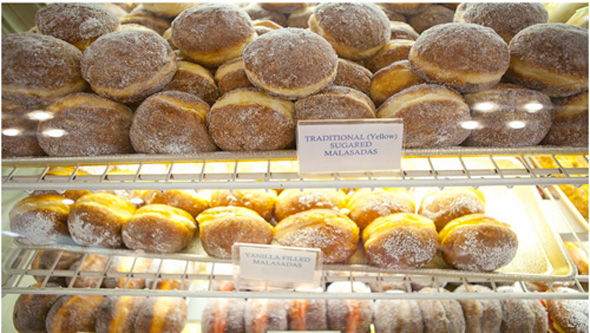MALASADAS: FROM HUMBLE BEGINNINGS TO HAWAII CONFECTION ICON

The malasada, a small, deep fried dough confection, has become integrated into the broad spectrum of “local food.” The Portuguese sweet treat was first brought to Hawaii by Portuguese laborers from the Azores and Madeira Islands who came to work in the sugar plantations. It can be most easily described as a donut without a hole. It is known as filha in Portuguese.
Traditionally prepared for Mardi Gras celebrations, when Catholic Portuguese in Hawaii would need to use up all of their butter and sugar before the start of fasting for Lent, the malasada’s presence has far surpassed the religious context of their introduction in Hawaii.
Indeed, the malasada is ubiquitous at Hawaii gatherings. Whether it’s an office birthday party, a little league post-game potluck, or a baby’s first birthday luau, there always seems to be at least one box of the sugary treat at any gathering that involves food.
Where to Find Them
Leonard’s Bakery in Kapahulu on Oahu is Hawaii’s most famous maker of malasadas. Tourists and locals alike line up daily for boxes of fresh malasadas, served hot. Leonard’s can make well over 1,000 malasadas in a single day.
There are many other malasada makers in Hawaii, including Liliha Bakery on Oahu. Punaluu Bakery on Hawaii Island, Lulu’s on Maui, and Kauai Malasadas are also popular spots for locals and tourists seeking the malasada’s warm, chewy goodness.
The annual Punahou Carnival on Oahu, which welcomes tens of thousands of attendees each year, is famous for its malasada tent. It is where families and friends agree to meet or regroup and it is always a veritable beehive of activity. During the run of the two-day event, hundreds of volunteers will make a staggering amount of the much-loved pastry, a number that routinely reaches into the hundreds of thousands!
Although malasadas are traditionally made without any filling, over the years malasada makers have introduced a variety of doughs and fillings. Most popular among these additions are haupia (coconut pudding), guava, passion fruit, sweet cream, and chocolate.
Of course, many Hawaii families forgo the trip to the bakery for malasadas, and instead make the cherished confections themselves, employing long-held family recipes in a tradition that goes back generations. Like so many things in Hawaii, malasadas came from far away and have become an iconic part of Hawaii’s diverse cultural melting pot.
